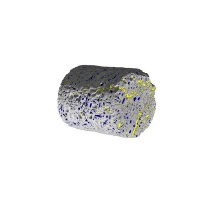How liquids or gases (fluids) spread in porous media, for example in rocks, and to which deformations this leads plays a role in very many fields of application. Examples of this are the optimisation of fuel cells, the storage of carbon dioxide or methane underground, the prediction of landslides after heavy rain or the transport of medicaments in human tissues.
The collaborative research field (SFB) 1313 has set itself the target of developing a fundamental understanding of how the interfaces – for example between two fluids or between the fluid and a solid material – influence flow, transport and deformation in porous media. On the one hand it should be quantified which influencing factors like pore geometry, the heterogeneity and cracks in the porous medium have on the dynamics of the flow processes. On the other hand mathematical and numerical models should be developed with which the impacts of processes that take place on very many small scales can be integrated into flow simulations.
At the centre of the research there are three representative fields. Project field A treats complex exchange processes of mass, impulse and energy at the border of porous medium and air flows as they occur, for example, when water evaporates in air. Project field B makes complex crack and failure processes in porous media the subject of discussion. Project field C deals with changes in the pore space on the basis of processes at the interface between fluid and solid material phase. This is the case, for example, when salt precipitates in the ground and the pore spaces are minimised through this, thus leading to suppression processes.
The research combines mathematical and numeral modelling with multi-scale, image-based experiments. In another, superordinate project field the focus will be on visualising the simulation and experimental results, to validate the models and to link multi-physics and multi-scale simulation environments. In addition, a new graduate school is to be set up in the framework of the CRC.
Spokesman
Univ.-Prof. Dr.-Ing. Rainer Helmig
University of Stuttgart
Faculty of Civil and Environmental Engineering
Institute for Modelling Hydraulic and Environmental Systems
Department of Hydromechanics and Modelling of Hydrosystems
Email
Prof. Dr.-Ing. Rainer Helmig: Ground water and the competition for utilizing the subsurface
June 11, 2018 7:00 PM
The subsurface or underground is used in a variety of different ways, even though the various uses often serve entirely different purposes. The ground water system is the most important source of drinking water with the best water quality – and not only for Baden-Württemberg; but, the subsurface also serves as a storage medium or even temporary or final disposal area for waste, contaminated or natural materials. Recently, such practices also include storing gases such as carbon dioxide to reduce greenhouse gases in the atmosphere.
This lecture is part of the series “Water – Habitat, Haven, Resource”. The lecture series brings together aspects of how we handle water and its importance with scientific research from the various fields.
Collaborative Research Centers at the University of Stuttgart
In the Collaborative Research Centers (CRC), sustained by DFG for up to twelve years, researchers collaborate on interdisciplinary, challenging, and costly research projects. CRCs that are permanently located in one university are differentiated from the so-called Transregios (CRC-TRR) that are spread over several university locations.
At present, four Collaborative Research Centers and three Transregional Collaborative Research Centers are housed at the University of Stuttgart. Besides, the University plays a major role in each two additional CRC and Transregios. Added to this University Stuttgart is speaker in four ongoing DFG Research Training Groups and we have two DFG Priority Programs as well as numerous Research Units.


